Ehecachichtli
An ancient noise generator with tubular windway, whistle of air, whistle of wind, whistle of the death, aerophone of double diaphragm or aerophone with air spring.
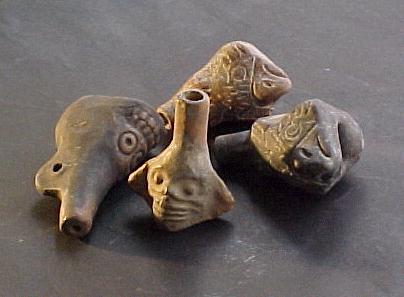
Models of Gregorio and Mario Cortes Vergara brothers.
Roberto Velázquez Cabrera
Virtual Research Institute Tlapitzcalzin.
(Consultation document)
First version November 1, 2003. Last version September 13, 2011.
A new related paper on the "Death whistle" was presented in the Special Sessions on Acoustics of Ancient Sound Instruments of the 2nd Pan-American and Iberian Meeting on Acoustics. Cancú, México, 15-19 November 2010. 160th ASA meeting - 7o Congress FIA - 17o Congress IMA.
Introduction.
This work is with the purpose to analyze the most known member of the family of aerophones that generate sounds like the wind. Their sonorous hearth is the bucal Ehecachichtli, analyzed with certain depth in other study (1).
It is convenient to point out that the air and the wind were very important in the ancient Mexican cultures, because they were related to one of the most important and ancient gods also associated with life, the sky and the creation: Ehécatl-Quetzacóatl.. Iconographic representations exist that show the wind god using smokers (sahumadores) and it is known that exist some which have "wind whistles" in the handle extreme inside the mouth of a snake. They produce sounds like the air or winds of the underworld, like roarer Tlemaitl.
The first researcher who started to seriously investigate these aerophones was engineer Jose Luis Franco in 1971 (1). In the part designates as of Double Diaphragm or of air bellows and included a drawing of the air whistle, commented that they can belong at least to the eight century B.C. in an Olmec context.
Later other investigator published texts and drawings of those aerophones like Samuel Marti in 1986 (3), Pablo Castellanos in 1970 (4), Guillermo Contreras in 1992 (5) and Susan Rawcliffe in 1992 (6).
This "air whistle" is the member of the aerophone family that produce noise, best known at the present time by some artisans who still make them. The best that I have been able to hear and examine are those of Cortes brothers in Texcoco.
It is known that several ancient whistles of this subfamily in storage places, in national museums and of the exterior. Unfortunately, no acoustical studies of any ancient air whistle are known, from the majority of them the public not even the pictures has even seen.
Replicas and experimental models.
For as long as the lack of interest and opposition persist from the curators and administrators of museums to deeply analyze the substantive function of ancient aerophones under their care, other option is to use experimental models.
It has been seen experimentally that the body of these designs adapts to a infinity of zoomorphous and anthropomourphous forms and to those of the underworld beings, from the ancient mythology and from imagination. Several procedures have been found for their clay construction. Clay is the best material for their construction. It is very difficult to make them out of solid materials. The author has build several hundreds of them. Others are shown in this picture with other members of the family:
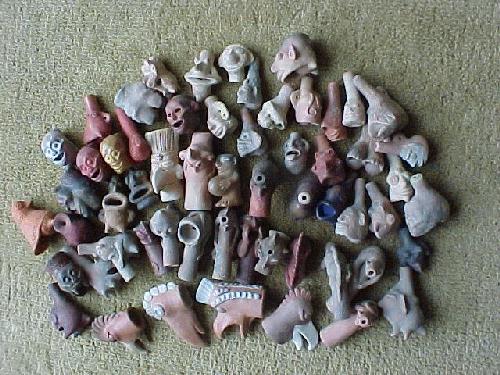
Some experimental models air and noise whistles.
Internal structure and general operation.
The best known internal structure can be clearly shown with a dissected model made for didactic purposes, such as the one shown here:
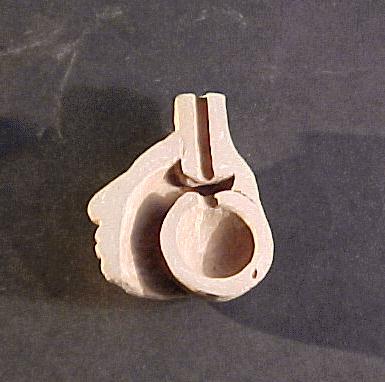
Dissected model of clay.
Ehecachichtli is very easy to operate, is like any whistle of flute with air duct. The input air flow is introduced through a tubular air duct then it goes through the two holes of the "chaos and noise generator chamber" and interacts with a globular resonating chamber (which functions as a Helmholtz resonator) and another exit chamber (which generally has a similar effect to those of the "bells" of other aerophones). Mario Cortes has a powerful sonorous design, a little different, with a edge into which the air hits.
In the open study of bucal Ehecachichtli (1) the functioning of the sonorous mechanism inside the mouth is described. The air whistle functions in a similar way, but outside of the mouth, but in this last case there is no possibility to alter the internal structure, as it happens with the bucal type.
It is possible to make multiple whistles of this type, but the sounds are shorter or their power is low, because several resonators have to be operated with the same amount of operator's air.
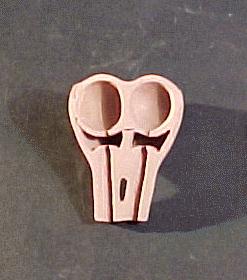
Cut view of a dissected double air whistle.
Sonorous analysis.
The methods for musical analysis are of no use in this case, because the sounds are not musical in the modern occidental concept. Instead of searching for similarities with notes and scales of imported music, it is more proper to apply technical tools and scientific views without ethnological or cultural traces to find the physical properties of their artifacts and their sounds as well as their relation with the human and animal sonorous perception. Their detailed analysis requires: organological, acoustical, signaling, fluid's dynamics, visualization of chaotic dynamic systems techniques, in addition to those of their anthropological and archaeological fields, even if these ones are very limited in this case.
It has been commented that the main characteristic of these whistles is that they can produce sounds very similar to those of the air. At times their sound are not unpleasant, but with small variations in the dimensions of their sonorous mechanism, they can generate hairy sounds. The components of their signal in the frequency domain, can be shown with a spectrogram:
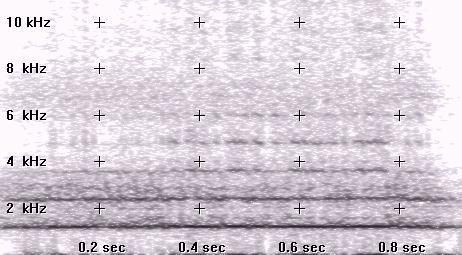
Spectrogram of a sound of a whistle of Gregorio Cortés.
In this case a sound with a strong fundamental or crest and harmonics are produced, but it has noise signals between them. It has no tonal holes but the produced sounds can be altered a little if an additional chamber is formed with the hands around the exit chamber hole (just like when playing the modern Harmonica). Usually, they are played individually, however, some, like the Tribu group, the four members have all played them at the same time.
However, their acoustical possibilities have not been explored nor utilized. The most complex effects can be produced when a large group of whistles are played at the same time, because they can generate complex beats and interferences. Also, it is possible to produce more complex sounds by inducing in a complex form the excitation air flow.
Generally, the produced signals are very much like to those of the "pink noise", but some can have peaks or crests. That type of noise has not been deeply studied, because normally noise is considered undesirable, while it is produced in nature and even in the human voice.
Audible perception.
It is more convenient to analyze those sounds in function of the audible perception capacity. In the spectrograms of all the analyzed cases, it has been seen that the sounds are generated inside the band of highest audible sensitivity for humans (1 to 5 kHz), which is shown in the graph of audible perception contours. Therefore, those sounds bother some people, but for that reason it means that their sonorous mechanism were designed and built so their sounds could be heard with high intensity at short distances or to be heard at long distances for humans.
Audible perception contours of equal sonorous levels for pure tones with the listener in front of the source (7).
The lowest curve of the graph shows the average audible low limit for a normal human ear (not damaged). The frequency for maximum sensitivity is close to 3 to 4 kHz. Higher and lower tones require higher Lp values (NIre10^-12 W/M2). The audible limit is the minimum perceptive level of intensity from free field intensity of a tone that can be detected from a frequency over the whole range of ears.
Acoustic power.
Another important factor in the analysis of sound generators is their acoustic power. The real radiated acoustic power of air whistles can be high, up to 0.126-0.2 Watts (100-103 dB at 1 m and 0 degrees), but lower than the bucal aerophones of the same family, 1 Watt (109 dB), and their perceived power is more due to their band of frequency and because peaks with noise are generated in the same band, which straightens the audible effect.
The radiated acoustic power was estimated with formulas 1 and 2 expressed in MS Excel format:
I = + (10 ^-12) * 10 ^ (dB/10) (1)
W = 4 * PI() * I (2)
Where,
I = sound intensity (W/m2)
dB = sonorous pressure measured with a sonometer (dB) at 1 meter and 0 degrees.
PI = 3.1416....
W = radiated acoustic power (Watts)
The other developed members of the two hole aerophones family that have been found in several complex forms in Mesoamerica, have not been located in the literature of other zones in the exterior. The acoustical characteristics of the whistles make them ideal to be used in rites and ceremonies in rooms and caves, with impressing effects, if several are played at once. It is also possible that they have therapeutically effects, because some of their sounds are similar of those used to improve the mental and physical health of persons with patented methods. But its confirmation is matter of advanced investigation.
It has not been possible to know in detail the exact functioning of the chaos and noise generator due to the fact that no experts have been found with well equipped laboratory for the visualization or simulation of the dynamic of turbulent fluids, being interested in the formal analysis of those extraordinary Mexican aerophones.
Referencias.
1. Velázquez-Cabrera, Roberto. "Estudio de aerófonos mexicanos usando técnicas artesanales y computacionales" Tesis de maestría en ciencias de la computación, Centro de Investigación en Computación. IPN. 7 de Junio de 2002.
2. José Luis Franco C. Musical Instruments from Central Veracruz in Classic Times.Ancient Art of Veracruz. Exhibition Catalog of the Los Angeles County Museum of Natural History, 1971.
3. Contreras Arias, Guillermo. Atlas Cultural de México. Música. , SEP-INAH-PLANETA, 1988.
4. Martí, Samuel. "Instrumentos Musicales Precortesianos". INAH. 1968
5. Castellanos, Pablo. "Horizontes de la Música Precortesiana". FCE, 1970
6. Rawcliff, Susan. "Complex Acoustics in Pre-Columbian Flute Systems". EMI. Vol. 8. # 2, 1992. (http://www.windworld.com/emi/). (http://www.artawakening.com/soundworks/)
7. Fletcher, H; Mousan, W.A. "Loudness its definition, measurenment and calculation". JASA, Vol 5. pp 82-108, 1933




